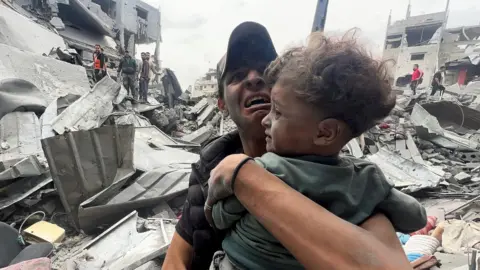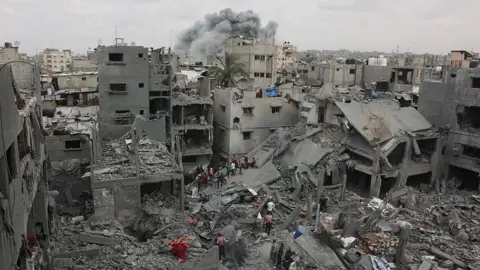Israeli strike on Gaza residential building kills 29, medics say
 Reuters
ReutersAt least 29 Palestinians, including children, have been killed in an Israeli air strike on a multi-storey residential building in the east of Gaza City, a local hospital says.
The Hamas-run Civil Defence agency said warplanes targeted the area near al-Hawashi mosque in the Shejaiya neighbourhood on Tuesday morning.
It initially reported that 23 people were killed but warned its first responders were searching for two dozen others under the rubble. In the evening, it announced 15 bodies had been recovered, without giving an updated death toll.
The Israeli military said it had struck a "senior Hamas terrorist" who was responsible for planning and executing attacks in the area.
Numerous steps were taken to mitigate harm to civilians, including the use of "precision weapons", it added.
The military also accused Hamas of violating international law by deliberately using the civilian population as human shields.
Video from Shejaiya showed the dust-covered bodies of small children being carried away from the rubble by distraught relatives and rescue workers.
Ayub Salim, 26, told the AFP news agency the area around the residential building struck on Tuesday morning was "overcrowded with tents, displaced people and homes".
He said it was hit by "multiple missiles" and that "shrapnel flew in all directions".
"Dust and massive destruction filled the entire place, we couldn't see anything, just the screams and panic of the people," he added. "It is truly a horrific massacre."
Hamas also said the Israeli military had "committed a bloody massacre".
Thousands of Shejaiya residents fled last week after the Israeli military ordered the evacuation of much of the neighbourhood, saying it was operating with force to destroy "terrorist infrastructure".
But residents said the area struck on Wednesday was not covered by the evacuation order, so many families had remained there.
"We were told this was a safe area for the displaced, yet they are targeting residential blocks with lethal missiles. What have the children done? Do they fire rockets at the Israeli army?" an elderly man in Shejaiya told BBC Arabic's Gaza Lifeline programme.
 AFP
AFPEarlier on Tuesday, Gaza's Hamas-run health ministry said at least 33 people had been killed in Israeli attacks over the previous 24 hours.
That brought the reported total of those killed since Israel resumed its air and ground campaign against Hamas on 18 March to 1,482.
The Israeli military meanwhile said its aircraft had struck more than 45 "terror targets" across Gaza over the past day, including weapons manufacturing sites and rocket launchers.
It also said ground forces were advancing into Shejaiya as well as the so-called "Morag Corridor" in southern Gaza.
The military corridor is being established by seizing territory between the city of Rafah, whose residents have been ordered to evacuate, and neighbouring Khan Younis.
During a visit to the area on Wednesday, Israeli Defence Minister Israel Katz said: "We are now slicing through the strip, and we are increasing the pressure step by step, so that they [Hamas] will give us our hostages."
"All of Rafah will be evacuated and turned into a security area. This is what we are doing now," he added, according to the Ynet news website.
The BBC has asked the Israeli military for comment.
Another 390,000 people have been displaced over the past three weeks, with two-thirds of the territory now designated by the Israeli military as "no-go" zones or placed under evacuation orders, according to the UN.
The UN has also warned that supplies of food, medicine and fuel have dried up because Israel has prevented any deliveries of humanitarian aid for a month to put pressure on Hamas.
On Tuesday, Secretary General António Guterres condemned the Israeli blockade, saying it violated international law and had opened "the floodgates of horror".
"Gaza is a killing field and civilians are in an endless death loop," he added.
The Israeli foreign ministry rejected Guterres' criticism, saying he had "not let the facts get in the way when spreading slander against Israel".
"There is no shortage of humanitarian aid in the Gaza Strip - over 25,000 aid trucks have entered the Gaza Strip in the 42 days of the ceasefire. Hamas used this aid to rebuild its war machine," spokesman Oren Marmonstein said.
On Monday, the heads of six UN humanitarian agencies had described Israel's assertion there was enough food for Gaza's 2.1 million population as "far from reality on the ground".
They called for the protection of civilians, the facilitation of aid deliveries, the release of the hostages held by Hamas, and the renewal of the ceasefire.
Mediators are continuing to try to resurrect the ceasefire, which started on 19 January and saw Hamas release 33 Israeli hostages - eight of them dead - and five Thai hostages in exchange for about 1,900 Palestinian prisoners and a surge in humanitarian aid entering Gaza.
Israel said it resumed its offensive due to Hamas's refusal to accept a proposal for an extension of the ceasefire deal's first phase and the release of more of the 59 hostages it is still holding, up to 24 of whom are believed to be alive.
Hamas accused Israel of violating the original agreement, according to which there would be a second phase where all the remaining living hostages would be handed over and the war brought to a permanent end.
The Israeli military launched a campaign to destroy Hamas in response to an unprecedented cross-border attack on 7 October 2023, in which about 1,200 people were killed and 251 were taken hostage.
More than 50,840 people have been killed in Gaza since then, according to the territory's health ministry.
Correction 10 April 2025: This article originally said the Israeli defence minister was quoted by the Jerusalem Post. In fact, he was quoted by the Ynet website and we have amended this sentence to make that clear.
